Enniscrone Golf Links is situated in a beautiful location, positioned along the edge of the Atlantic Ocean in the West of Ireland, on the Wild Atlantic Way. It is is on the north side of the Moy Estuary and boasts some of the largest sand dunes in Ireland.
The club is over one hundred years old, having been established in 1918 as a nine hole facility. The first recorded mention of the club appeared in the Western People on August the 19th 1922 when it was announced that medal competitions were being held at Enniscrone Golf Links. It was not until 1930 however, that nine holes were laid out on flat land at Bartra and the course was formally opened with membership of forty eight, 90 years ago on St. Patricks Day 1931. The membership fee for the year was £1.
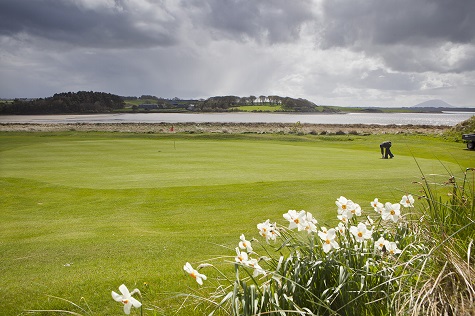
The 10th green with spring narcissi
The club employed a greenkeeper in 1933. His fairway mower was horse driven and a lawnmower cut the greens. In 1947, a clubhouse was built at a cost of £400. However, war, emigration and economic hardship throughout these difficult times combined to produce a declining membership and by 1959 there were only fourteen club members.
The building of a power station at Ballacorick and the River Moy drainage scheme in the 1960’s brought a revival and with it came prosperity and new golfers to the area. By 1969 membership had grown to just over one hundred. The course was in good condition but livestock on the course created problems necessitating wire fencing around the greens.
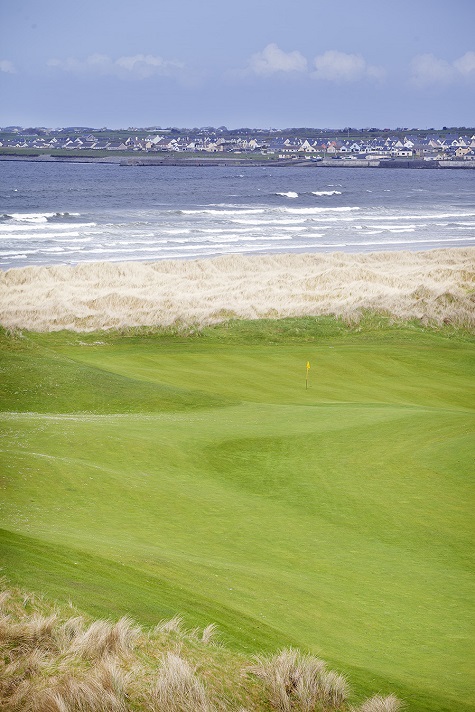
The 14th green with the town of Enniscrone in the background
Members began looking longingly at the dunes and dreamt of an 18-hole links course. By March 1970 the great Irish course designer, Eddie Hackett, was hired to design a new 18-hole layout. He shaped and blended holes through the dunes with little interferance of the natural terrain. It was at Enniscrone that Eddie Hackett built some of the best golf holes of his long and distinguished career. In 1972, the aquisition of a new lease agreement was very important for the club and allowed wire fencing of the course (12 miles of it!) to exclude livestock. With just two permanent employees, along with the voluntary labour of members, saw the course and a new simple clubhouse opened in 1974 with Eddie Hackett driving the first ball. This was followed by an exhibition match featuring golf professionals Christy O’Connor Senior and John O’Leary.
Throughout the 1980’s club development continued, with a new clubhouse being built in 1989. By 1999, the skilled links designer, Donald Steel, was commissioned to reroute the golf course directly into the sand dunes. Steel added 6 new magical holes through the dunes, and added 3 new holes on the flat land to 6 of the Hackett holes to produce the Scurmoew 9-hole golf course. This turned Enniscrone into a 27-hole facility on 400 acres of land. The clubhouse also received a new extension and the new course was opened in 2001.
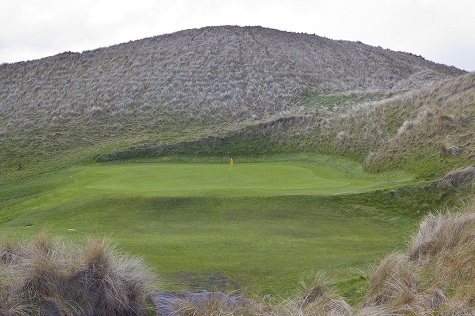
The 12th green was designed by cutting into one of the sand dunes
The financial crash that started in 2008 affected many golf clubs around the country. Golf clubs in Connaught were particularly hard hit and Enniscrone was no exception. To give an example of this, in 2007, the club boasted over 1000 members. Ten years later there were just 700 members, bringing a substantial loss of income to the club.
Despite the reduction in income, Enniscrone Golf Links weathered the financial storm. However, the lockdowns, due to Covid-19 forced the club to close its gates for many weeks in 2020 and in 2021, seeing, yet again a drop in income due to the small amount of green fees received.
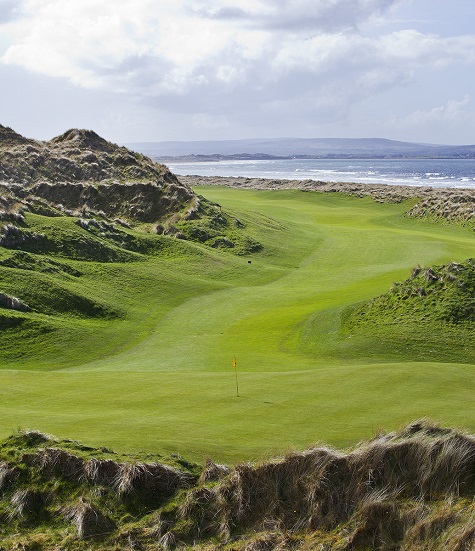
The magnificant 16th par 5 hole
Not allowing the grass to grow under their feet, the club took advantage of no golfers playing the course. They spent €30,000 on drainage and repairs, with no delays and interferance from golfers. The course was able to rest from golf traffic, so topdressing and overseeding were also able to be carried out with no interferance.
Enda Mulrooney is the head greenkeeper at Enniscrone and he began working with the club in 1982. In 1997, on the retirement of long serving head greenkeeper, Robert Coleman, Enda was promoted as Head Greenkeeper. “That was a strange year for me because shortly after I was appointed to the top position I was told that Enniscrone would be hosting the 1997 West of Ireland Championship” said Enda. “I must have done ok that year as the club hosted the same event in 1998 and 1999”. Past winners of the West of Ireland Championship include Padraig Harrington, Rory McIlroy and Shane Lowry. Enniscrone also held the Irish Close Championship in 1993 and 2009.
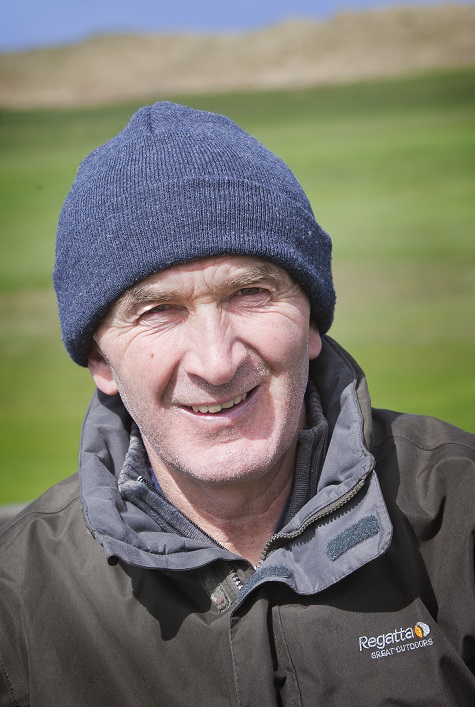
Head greenkeeper Enda Mulrooney
Enniscrone is so highly regarded that it has maintained a top twenty listing in the top one hundred golf courses in Ireland. It is currently ranked 13th in Golf Digest’s Top 100 Courses in Ireland 2020.
Course maintenance
Five full time greenkeepers maintain the 27-hole course. Enda’s assistant is long time and experienced staff member, Ciarán Sweeney. Like Enda, Ciarán has been working at Enniscrone for almost forty years. He knows the course like the back of his hand and is well capable of stepping up to the mark when Enda is away. There is an active greens committee and club member, Joseph Quinn, is the greens convener. Because there is no golf being played at present, Joe would regularly take photos of the work in progress out on the course and share it with the greens committee’s WhatsApp group.
“It’s a way of keeping the committee informed that work is still continuing out on the course during the pandemic” said Joe. In Summer two extra staff are hired to maintain this busy course.
One of the objectives of the club’s agronomy programme is to create conditions on the greens that favour the development of a sustainable turf mixture of fescue, bent and annual meadow grass. Fungicides have not been used on the course since 2011. Natural plant immunity is encouraged by sound greenkeeping practices such as regular aeration, top dressings light verticutting and low levels of organic fertilisers such as liquid seaweed. “When a disease outbreak occurs, such as fusarium, I apply sulphate of iron granules in its raw state – no dissolving with water or mixing with sand. Applying 2 x 20kg bags for every 3 greens seem to work” said Enda.
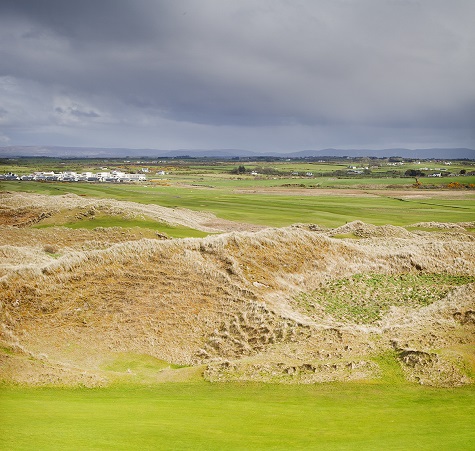
The view looking towards the Scurmore course
Greens are mown at 4mm in summer, increasing to 6mm in winter. During dry weather they are sometimes rolled instead of mown. Sand topdressing is applied every two weeks. The surrounds and tees are cut at 10mm and the fairways at 12mm. Fairways are topdressed in the Spring and Autumn. During the winter a liquid feed mixture of sulphate of ammonia and sulphate of iron is put out on the fairways. This is changed to urea in the summer. The semi rough is mown at 27mm and the rough at 44mm.
Recycled compost called New Leaf (sourced from County Armagh) is used in the divot repair mix. Golfers are encouraged to bring a divot repair bag to repair their divots. In the good old days before lockdown, when golf was allowed to be played, a group of ten club volunteers would meet once a week, usually on Tuesdays, to repair divots on tees and fairways from March to November. They are affectionately known as the Tuesday Divoters. As soon as golf is allowed to resume again, they will be back out with their buckets and trowels.
Irrigation is installed on the tees, greens and fairways. Water is harvested from a fresh water river and stored in two above ground tanks. A moisture meter is used to monitor irrigation times.
Areas of rough grass are cut using a flail mower. The cut grass is harvested to encourage the growth of more naturalised plant species such as wild orchids and sheeps fescue.
The fragile sand dunes
The sand dunes at Enniscrone are tall and impressive. They resemble the pyramids of ancient Egypt. Yet, despite their size, they are so fragile.
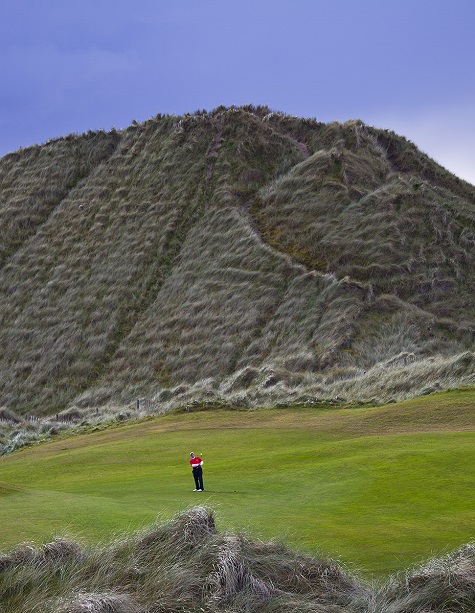
Enniscrone boasts some of the tallest sand dunes in Ireland
Recreational use of the dunes has had an impact on the vegetation. Marram grass, in particular, has a long and intertwining root system that is able to bind the dunes together. However they are very susceptible to foot traffic and, when damaged, the binding properties of the plant are lost. When the bare sand is exposed to wind and with no roots of the marram grass protecting it, a blow-out can develop. This is a concave area of exposed sand on the face of the dune.
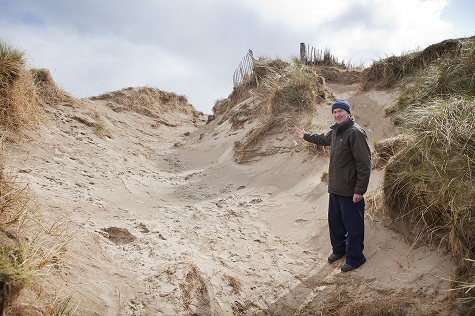
Enda Mulrooney shows the damage caused to the Cnoc na gCorp sand dune
A few years ago a well known GAA football team used the dunes to train on. They would run along the beach, cut through the dunes and run up one of the tallest dunes on the course. People thought this was a great idea and decided to take up this challenge for themselves. However it damaged the dune and and the club installed timber fencing to discourage this activity. This sand dune, which forms the backdrop to the 14th green, is called Cnoc na gCorp, translated as hill of bodies as folklore believe it to be formed from bodies of Vikings killed there in the 9th century. Two years ago, Sligo County Council completed a survey on this dune and in November 2019 they carried out preservation work including using chestnut fencing, planting of marram grass and signage to discourage climbers from contributing to further erosion thus preserving the dune for future generations.
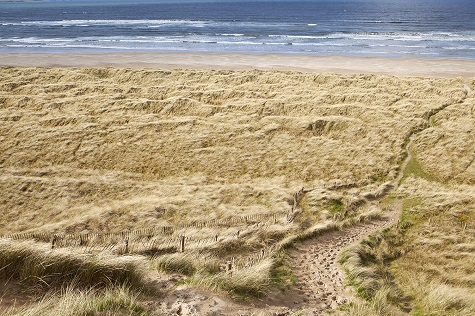
Foot tracks from the beach cause dune erosion
Wildlife
A lot of wildlife can be seen around the course. Brent geese overwinter and feed on the flat fairways of the 9-hole Scurmore Course, along with curlews and oystercatchers. The grassy salt marshes that are on the left of the 9th and 10th holes on the Dune Course are a main food resource for many birds during Autumn and Spring migration. The salt marshes play an equally important role as breeding sites for a number of wader species such as lapwing, shelduck and cormorants. Wildlife such as hare, in particular, and the occasional fox can be seen scurrying across fairways to the safety of the dunes. Many species of flora such as orchid, vetch harebell and heather colonise the golf course.
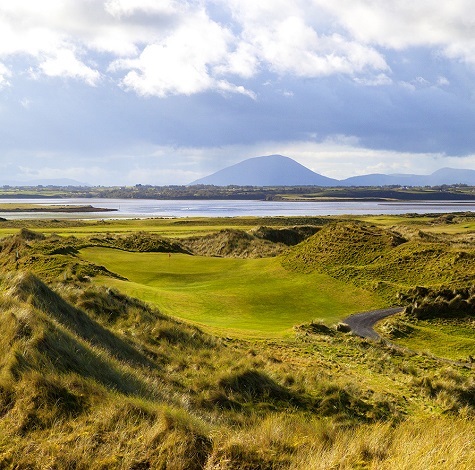
The 3rd hole on the Dune Course showing the Moy estuary in the background
Every hole at Enniscrone has a unique characteristic feature that is isolated from each other. The two courses here offer the golfer a variety of choice. The flat Scurmore Course is ideal for those that want to play a simple and relaxed game while the those who want a testing challenge, and experience true links golf, have the Dune Course to tame. If all doesn’t go according to plan out on the course, there is a fine clubhouse to retreat to and share the tales and woes of the round.
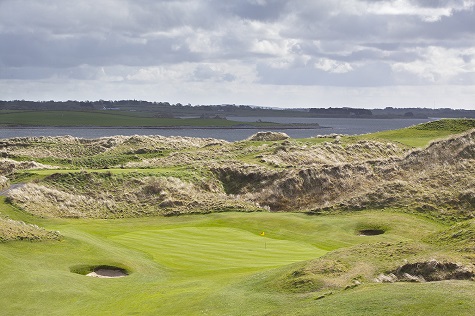
The 13th hole